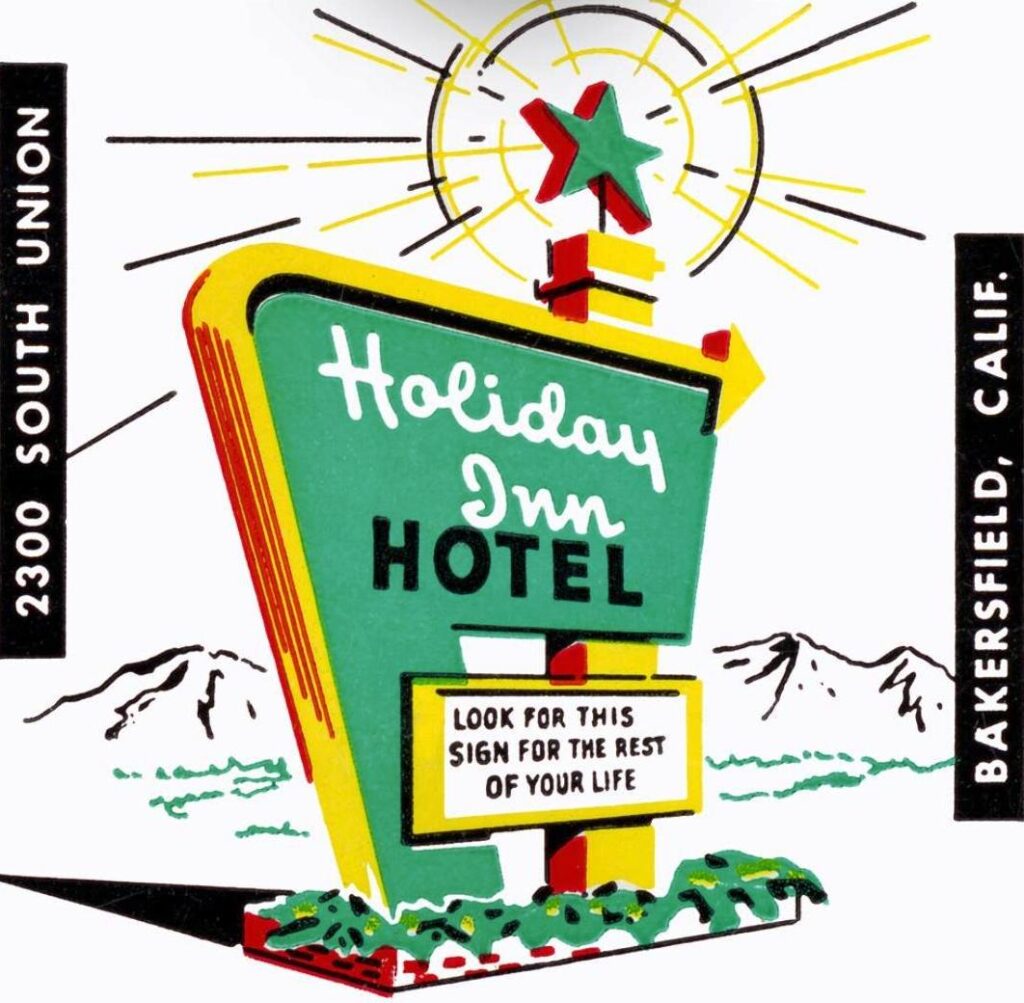Some of you are familiar with the story of how Kemmons Wilson and his family had a terrible vacation experience back in 1951 — and ended up creating an American treasure. On a family road trip to Washington, D.C., the Wilsons found roadside motels to be high-priced, uninviting, and cramped. What’s more, the amenities were few, and you charged extra for every kid you were traveling with (and with five children, that was a lot of money for the 38-year-old developer).
After the trip, Wilson immediately began making plans to build a roadside motel that would include a phone in every room, air-conditioning, a swimming pool, and a restaurant. More importantly, kids stayed free. As a joke, his architect, Eddie Bluestein, called it the “Holiday Inn” after the 1942 musical film starring Bing Crosby and Fred Astaire. Kemmons liked it, and the name stuck. In August 1952, he opened his very first Holiday Inn on Summer Avenue in Memphis, TN, just a year after his dreadful road trip to Washington D.C. Many more would follow soon after.
Kemmons franchised his chain as the Holiday Inn of America in 1957, with the stipulation that they all met his standards of cleanliness, uniformity, family friendliness, and accessibility to road travelers. By the following year, there were 50 Holiday Inns nationwide. A year later, there were a hundred. By 1964 there were 500. In 1968, Holiday Inn of America opened their 1000th motel in San Antonio, TX.
Nevertheless, if you traveled on a cross-country road trip with your family and stayed at a Holiday Inn anytime between the mid-1960s to the early 1980s, you might not remember much about the Mid-Century Modern architecture of the building or the interior design of the motel rooms. Rather, what you most likely remember is that big, glorious sign.
The Great Sign
While the first Holiday Inn was under construction, Kemmons went into the Balton & Sons Sign Company in Memphis and told them he wanted a 50-foot-tall sign that would be visible from both sides of the highway. The sign also had to have a changeable marquee to welcome different groups for different occasions. Oh, and it also had to be done in emerald green and yellow — the favorite colors of Wilson’s mother.
For $13,000, sketch artists Gene Barber and Roland Alexander created the sign that included a white, neon “Holiday Inn” written in a casual script on a curvilinear field of emerald green. This was attached to a red pylon with a yellow star atop that burst with beautiful brightness into the night sky. Attached to the sign was a yellow arrow with flashing orange lights that pointed weary drivers towards the motel’s office. It first lit up the Memphis sky the same night that the first Holiday Inn opened, and some say it was the best advertising Holiday Inn ever had. After all, as bright as it was, its message was simple: “This is a fun place for the whole family to stop and sleep for the night.”
Though it attracted station wagons full of families like moths to a flame, the Great Sign was more than just mere advertising. It soon became an icon known nationwide — a symbol of America’s prosperity and its post-war “can do” optimism.
Signs of the Times They Are A’Changing
By the late 1960s and early 1970s, styles were changing in America. Mid-Century Modern architecture, Googie design, and the Rat Pack had given way to the Beatles, shag haircuts, love beads, and earth tones. Everything became more mellow — signs included. Fun, quirky fonts of the 1950s and 1960s were replaced by the simplistic Helvetica and Geneva fonts. For the Great Sign, the writing was on the wall. People began seeing it as garish and tacky.
In 1979, Kemmons Wilson retired as CEO of Holiday Inns of America. He left the company entirely when he gave up his board of directors spot in 1982. Shortly after, all of the Great Signs were taken down and most of them demolished and scrapped. Kemmons called it the biggest mistake Holiday Inn ever made.
They were replaced with rose-colored back-lit signs and a more modern simple font. Sure, these new signs were far from garish — you could call them “safe,” even — and not very much fun.
There are, however, a couple of the Great Signs still hanging around. Not in front of Holiday Inns, mind you. They’re now located in museums like the American Sign Museum in Cincinnati, OH, and The Henry Ford Museum in Dearborn, MI.
Kemmons Wilson passed away in 2003 at 90 years old. If you want to pay your respects to the man who started it all, he’s buried in Memphis’ Forest Hill Cemetery Midtown. His headstone is easy to find. It’s the one with an engraving of the Great Sign reading, “Founder,” in the marquee and the arrow pointing to his name.
Stuckey’s – We’re Making Road Trips Fun Again!
Whether your next road trip is by car or by rail, it’s not really a road trip without taking Stuckey’s along. From our world famous Stuckey’s Pecan Log Rolls to our mouthwatering Hunkey Dorey, Stuckey’s has all the road trips snacks you’ll need to get you where you’re going.
For all of the pecany good treats and cool merch you’ll need for your next big road adventure, browse our online store now!
Stuckey’s – We’re Making Road Trips Fun Again!
